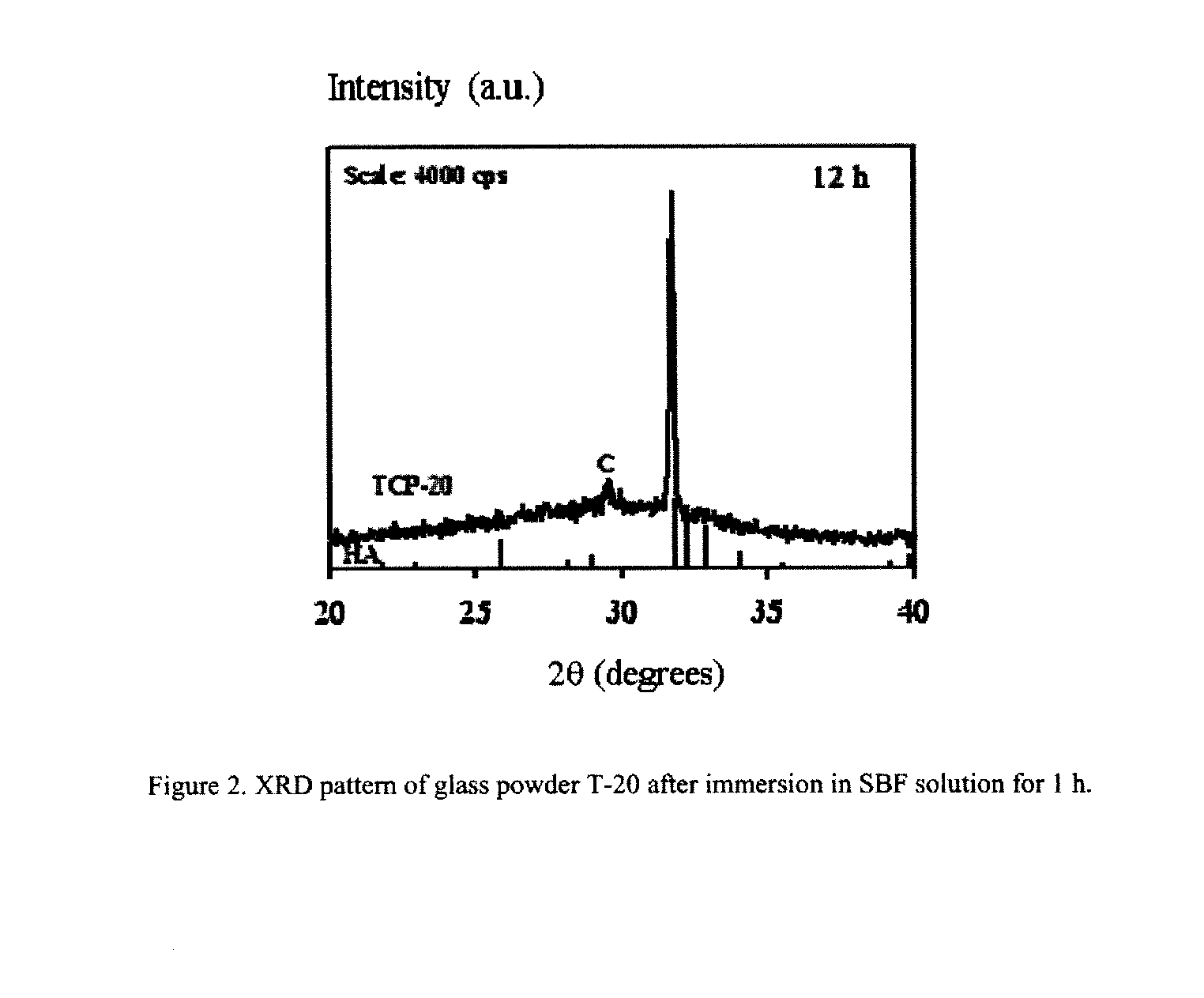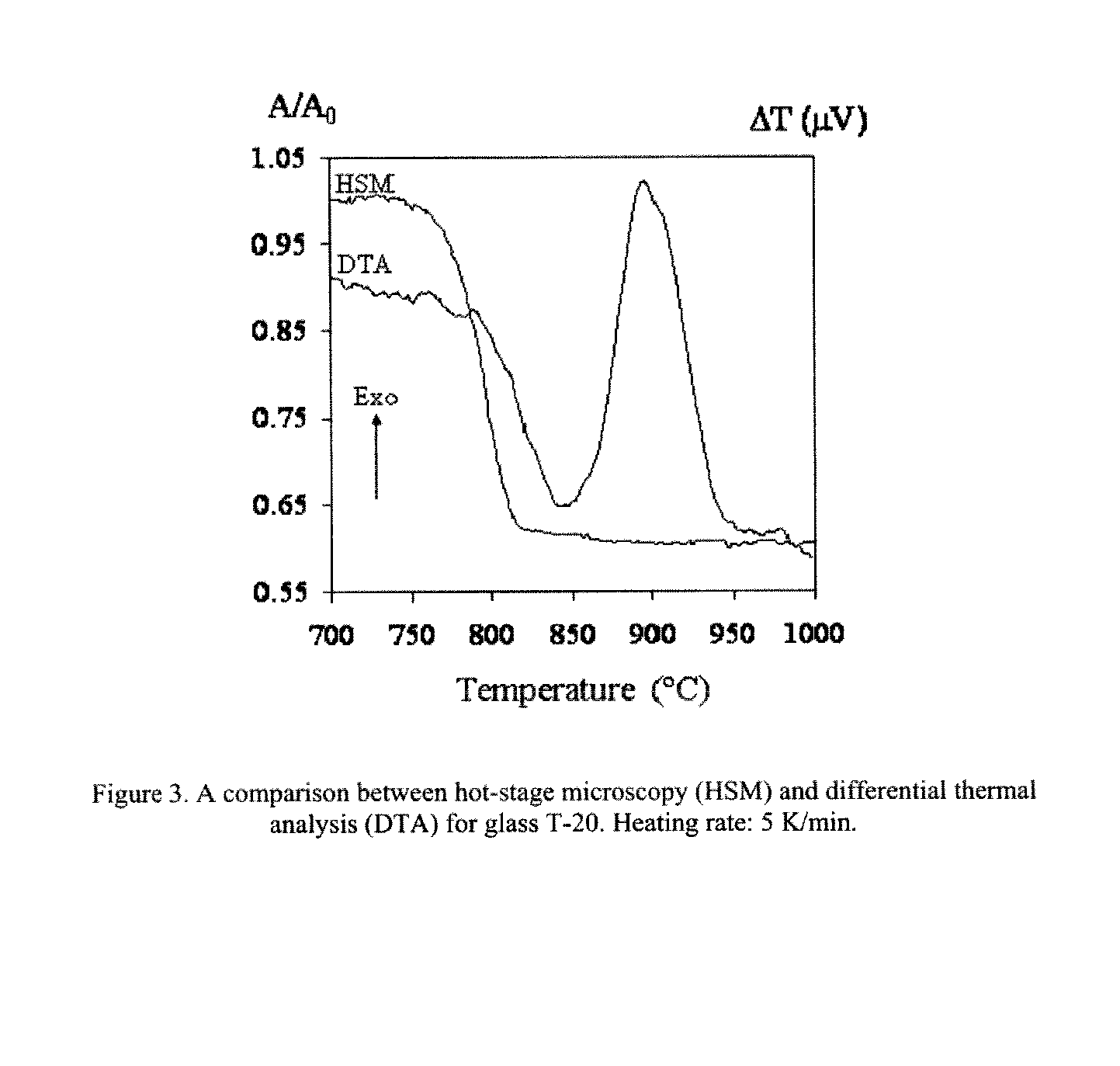Bioactive glass composition, its applications and respective preparation methods
- Summary
- Abstract
- Description
- Claims
- Application Information
AI Technical Summary
Benefits of technology
Problems solved by technology
Method used
Image
Examples
example 1
Exceptional Biomineralization Capability
[0155]A glass labelled as ‘T-40’ with composition 45.08 CaO-14.72 MgO-10.12 P2O5-29.45 SiO2-0.63 CaF2 (mol. %) was prepared through melt-quenching technique. The high purity powders of SiO2, CaCO3, MgCO3, NH4H2PO4 and CaF2 were used. Homogeneous mixtures of batches obtained by ball milling were preheated at 900° C. for 1 h for calcination and then melted in Pt crucible at 1590° C. for 1 h. The glass flits were obtained by quenching of glass melt in cold water. The frits were dried and then milled in a high-speed agate mill, resulting in fine glass powders with mean particle sizes of ˜5-20 μm. The amorphous nature of glasses was confirmed by XRD analysis.
[0156]As described above, 0.1 g of glass powder was immersed in 50 ml SBF solution for time period varying between 1 h-14 days. The glass powder exhibited the formation of HCA layer on its surface after 1 h of immersion in SBF solution, thus indicating a very high rate of bioactivity (FIG. 1). ...
example 2
High Biomineralization Capability
[0157]The glasses with compositions as presented in Table 1 were prepared through melt-quenching technique and crushed to powder form with mean particle sizes between 5-20 μm, in accordance with the details explained in Example 1. The amorphous nature of glasses was confirmed by XRD analysis.
TABLE 1Bioglass compositions (mol. %)VidroMgOCaOP2O5SiO2CaF2FA-3019.2535.185.3138.491.77FA-4017.0739.047.3334.122.44W-80—53.033.6442.121.21TCP-2019.2436.07 5.6138.490.59
[0158]As described above, 0.1 g of respective glass powders was immersed in 50 ml SBF solution for time period varying between 1 h-14 days. The glass powder exhibited the formation of HCA layer on its surface after 12 h of immersion in SBF solution, thus indicating a high rate of bioactivity (FIG. 2). These results demonstrate that the bioglass compositions reported in Table 1 may be used in various orthopaedic as well as dental applications as detailed in the description of the invention.
example 3
Good Sintering Ability
[0159]The glasses with composition as presented in Table 2 were prepared through melt-quenching technique and crushed to powder form with mean particle sizes between 5-20 μm in accordance with the details explained in Examples 1 & 2. The amorphous nature of glasses was confirmed by XRD analysis.
TABLE 2Bioglass compositions (mol. %)GlassMgOCaOP2O5SiO2CaF2F-1023.2028.181.6646.410.55F-2021.2931.573.4342.571.14T-1021.2932.003.5742.570.57T-2019.2436.075.6138.490.59
[0160]The sintering preceded crystallization in all the glasses (Table 2) as is evident from a comparison between DTA and HSM thermographs presented in FIG. 3, thus resulting in well sintered dense glass powder compacts after sintering in temperature range of 800-850° C. for 1 h. The crystalline content in the sintered glass powder compacts varied between 0-30 wt. % with diopside (CaMgSi2O6) as the major crystalline phase while fluorapatite may be / may not be present as a secondary crystalline phase as desc...
PUM
| Property | Measurement | Unit |
|---|---|---|
| Temperature | aaaaa | aaaaa |
| Temperature | aaaaa | aaaaa |
| Fraction | aaaaa | aaaaa |
Abstract
Description
Claims
Application Information
 Login to View More
Login to View More - R&D
- Intellectual Property
- Life Sciences
- Materials
- Tech Scout
- Unparalleled Data Quality
- Higher Quality Content
- 60% Fewer Hallucinations
Browse by: Latest US Patents, China's latest patents, Technical Efficacy Thesaurus, Application Domain, Technology Topic, Popular Technical Reports.
© 2025 PatSnap. All rights reserved.Legal|Privacy policy|Modern Slavery Act Transparency Statement|Sitemap|About US| Contact US: help@patsnap.com



